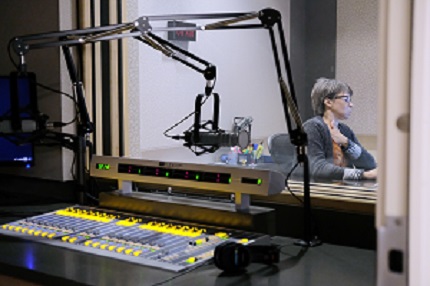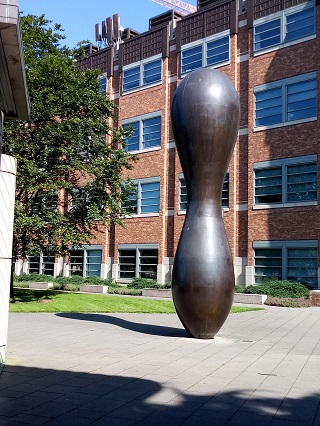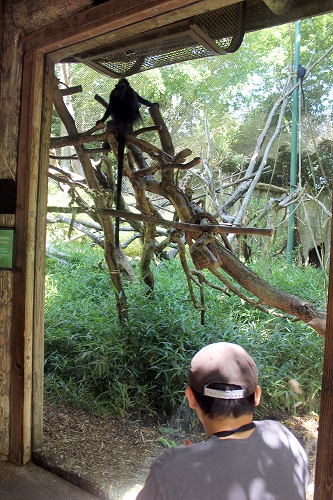Events
KUOW

Nearly everyone has heard the radio at some point in their life, whether it be in the car on the way to school or work. But what is it like to experience the process that creates the content you hear? DO-IT scholars were given the privilege to visit the headquarters of the Seattle area's preeminent radio station, KUOW 94.9. Located on University of Washington property, KUOW first went on the air in 1952, with the call number 90.5. It's original programming often consisted of university-related activities, such as class lectures and classical music. However, in 1970, it became an NPR member, switching to news coverage and becoming the radio station we know today. With old fashioned radios on the wall, and descriptions of the station's history, KUOW gives a great look at the process of radio. Led by Kelsey Kupferer, the Youth Radio coordinator, DO-IT scholars got to tour around the organization and see various recording rooms, hear a presentation on interviewing tips, such as recording quotes and asking questions that don't have a yes or no answer, and listen to Youth Radio stories.
Microsoft

You can't go very far into the Redmond area without noticing it. It looms over the skylight, a giant as much in appearance as reputation. What am I speaking of? The tech giant Microsoft, of course! Nearly two college campuses, the vast Redmond campus shows Microsoft's power. But for such a big company, it's surprisingly welcoming. DO-IT scholars got to visit the campus, and heard a presentation on assistive technology while also participating in a 'engineer a robotic dog' challenge. Scholars also visited the Microsoft/Xbox Inclusive Design Lab, where various products meant to allow persons with disabilities to experience videogames are created. With surround sound and universally designed controllers, the Lab is indicative of Microsoft's efforts to include people with disabilities in its company and allow them to influence decisions. It's a move that seems to represent Microsoft's ethos as a company, prioritizing people as a method of producing products. And it seems to have been paying dividends, with Microsoft dominating the tech industry and capturing promising new workers. Microsoft, despite being enormous, lends the idea that it cares about both its employees and consumers. In a world where disability is so often set aside, excluded, Microsoft represents an acceptance and even a celebration of those with disabilities. It's a valuable visit for those with disabilities and bound to be exciting for those who enjoy technology innovation. From seeing the vast potential of assistive technology, to brainstorming the processes behind making a product, Microsoft makes up one of the most interesting activities in the DO-IT program
Planetarium

Last Saturday morning, Phase I DO-IT scholars went to the planetarium to learn about astronomy. A college student majoring in astronomy was the one who presented it to us. The room was circular, like earth is. There were document cameras on the ceiling which was our visual. The presenter showed us constellations, planets, the planets' moons, the Milky Way Galaxy, the solar system, the planets' orbits, and the whole entire universe as we know it. In addition to showing us all the stars, planets, moons, etc. he explained to us what scientists know about them all and described the planets and stars' atmospheres. He even explained why Pluto is no longer considered a planet. He explained why Earth is the only planet that has life and whether or not there is life on other planets is still to be determined. Going to the planetarium was super informative and one of the most interesting moments while being at DO-IT.
The Mill Makerspace

After the planetarium, we went to the mill makerspace at McCarty Hall. There we learned about 3D printing, laser engraving, and vinyl printing. They were all very cool and awesome to watch. Technology at its best. I had never seen technology working in that way nor did I even know that 3D printing or laser engraving existed until then. Laser engraving is printing or engraving an image of your choice off of the internet onto either wood or acrylic. We would copy and paste the image onto Adobe illustrator, modify it to a reasonable size, and then save it and print. So he put both in the machine and then a laser engraver would put the image on the wood or acrylic. Then the laser would cut the wood and acrylic and everyone would take their images home.The 3D printing involved lots of math: Graphs, measurements, and guess and check. First the presenter showed us the steps of 3D printing and all the materials that were involved. Then she let us pick what we wanted to 3D print. We chose a mug. It printed out purple. It’s very small. The presenter told us if it was any bigger then it would take a lot longer to 3D print. 3D printing takes longer than an hour. Lastly, we did vinyl printing. Which was picking an image, copying/pasting it to Adobe illustrator, and printing it. Not engraving it. Printing it and making it into a sticker. I chose a picture of princess Tiana. The sticker is on the back of my laptop. All the presenters did whatever they could to help us. They made it very interesting and fun. And they encouraged us to experiment and try.
Karaoke Night

Last Saturday, after dinner and when the Phase II scholars just arrived, we did a karaoke night and sang lots of songs of all different genres. There were some duets, trios, quartets, and the audience sang along to some songs as well. The audience was very supportive and it was a fun activity. I sang "Mean" by Taylor Swift, "I won't say I'm in Love" from Hercules, and "How Far I'll Go" from Moana. I sang "Mean" with a Phase II scholar. Two people sang "Demons" by Imagine Dragons. Someone sang "New Rules" by Dua Lipa, lots of people sang songs from Hamilton, "I'm Yours" by Jason Mraz, and the finally and the best part of all was when Ryan and....Carlin sang "Staying Alive" by the Bee Gees. Overall, it was a wonderful time. One of the best and laid back moments of DO-IT. It was just fun. Even when you weren't singing it was great listening to other people. Everyone had unique voices.
The Zoo

Red pandas. Giraffes, jaguars. Poison dart frogs. A giant, horrifying spider. (Not a highlight, it nearly caused puking. What? Everyone hates spiders. ) Adorable parrots. DO-IT scholars got to take a trip to the zoo, on a nice, sunny, 85-degree day. Though the weather may have been hot, DO-IT scholars had a huge amount of fun traveling around and seeing the many animals on view. Seattle has one of the bigger zoos in the area, and the number of animals made four hours spent there pass by amazingly fast. The zoo began as a small menagerie on a real estate developer's estate, and after his death, was sold and moved to Phinney Ridge in 1889. Now, it's very popular, receiving many visitors per day, and has received many awards for its exhibit design. The zoo comprises 6 main areas in addition to a carousel and Zoomazium, for younger kids. Among them are the Temperate Forest, Tropical Rainforest, Northern Trail, Australasia, African Savanna, and Tropical Asia, and in total, these areas contain 1,090 animal specimens and 300 species. There's clearly no shortage of animals to view or activities to do, and those four hours barely covered the entire zoo for many. Amid the heat (water was a necessity), small groups traveled around the zoo, and then met for lunch in a field. Some of the more popular exhibits included the African Savanna and Australasia bird-feeding exhibit, but scholar Alison Barlow commented that she enjoyed seeing the grizzly bears the most, an opinion that Carlin Markestad did not share. Markestad enjoyed the snakes, and when asked why, stated it was "because of snek." (In this case, some backstory is required. Snek is a skinny, green, rubbery fidget toy who somewhat looks like a snake and is thus referred to as snek. Why is it spelled that way, you might ask? Well, because it's funny.) For Ellie, however, the tamarins (small, adorable golden monkeys) were the most interesting exhibit, because they were cool and cute. In the end, the zoo was an extremely popular piece of the DO-IT program. My highlight? The red panda. Though us humans required copious amounts of water to deal with the heat, the red panda decided to spend its day lounging on a branch, eyes closed, tongue out attempting to reach the mist in it's enclosure. Absolutely adorable.
Center for Neurotechnology

In the class at the Center for Neurotechnology we learned about how brain-computer interfaces are improving the lives of people who need them. For example, inserting electrodes on or in the brain can help someone with limited or no mobility move objects on screen or artificial arms with their minds. Other methods of improving lives involve inserting implants into either the eye or ear. Cochlear implants help restore some hearing in people who have poor hearing. Retinal implants help restore some vision in individuals with certain eye diseases. Advancements in prosthetic limbs are also an important step in replacing limbs lost through illness or injury. There are ways to control artificial limbs by rewiring the nerves that would normally go to the arm to the chest. The electrodes on the prosthetic arm go onto the skin where the nerves are. That way, the signals from the brain would travel on the nerves to the chest, where the electrodes from the prosthetic arm are. Thus, the arm moves as if it were a natural arm. Furthermore, the artificial fingers have pressure sensors to give a sense of touch to the user. In time, neurotechnology could be accessible to anyone.
